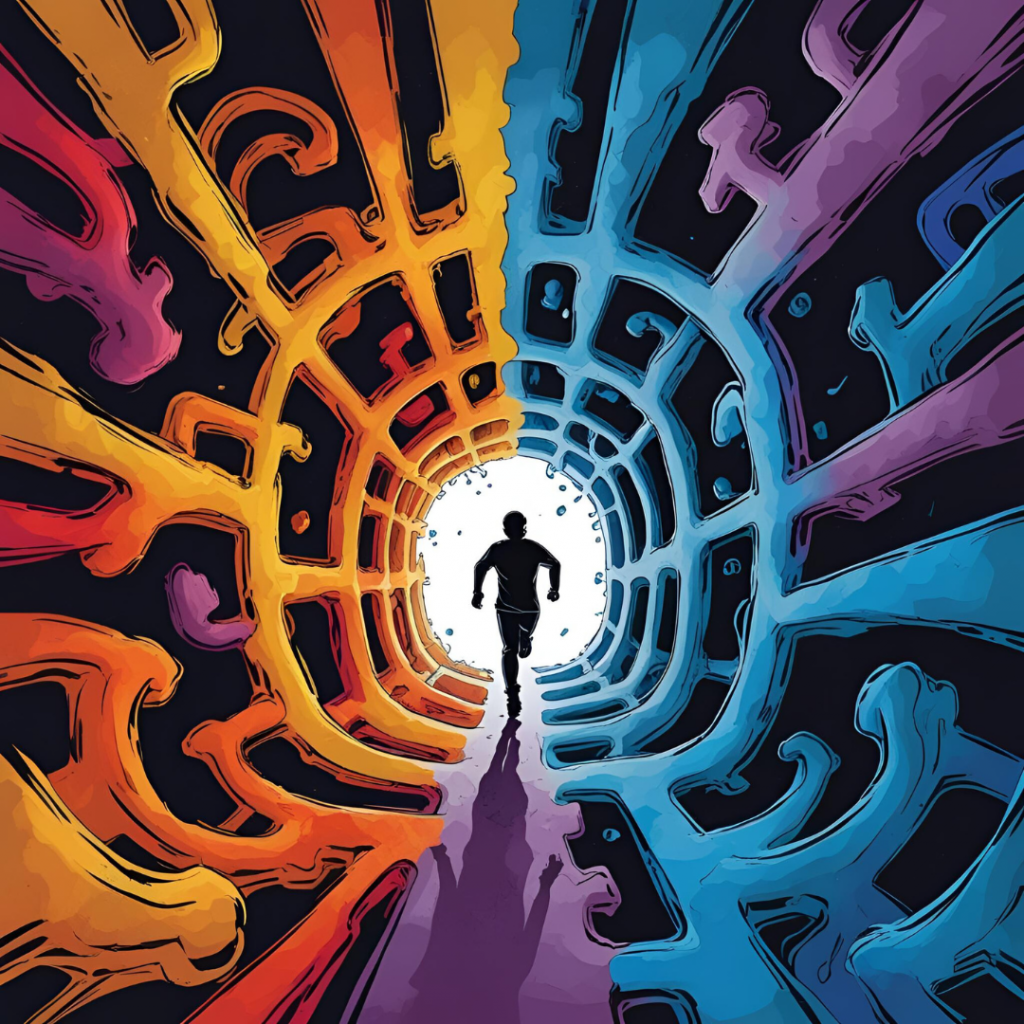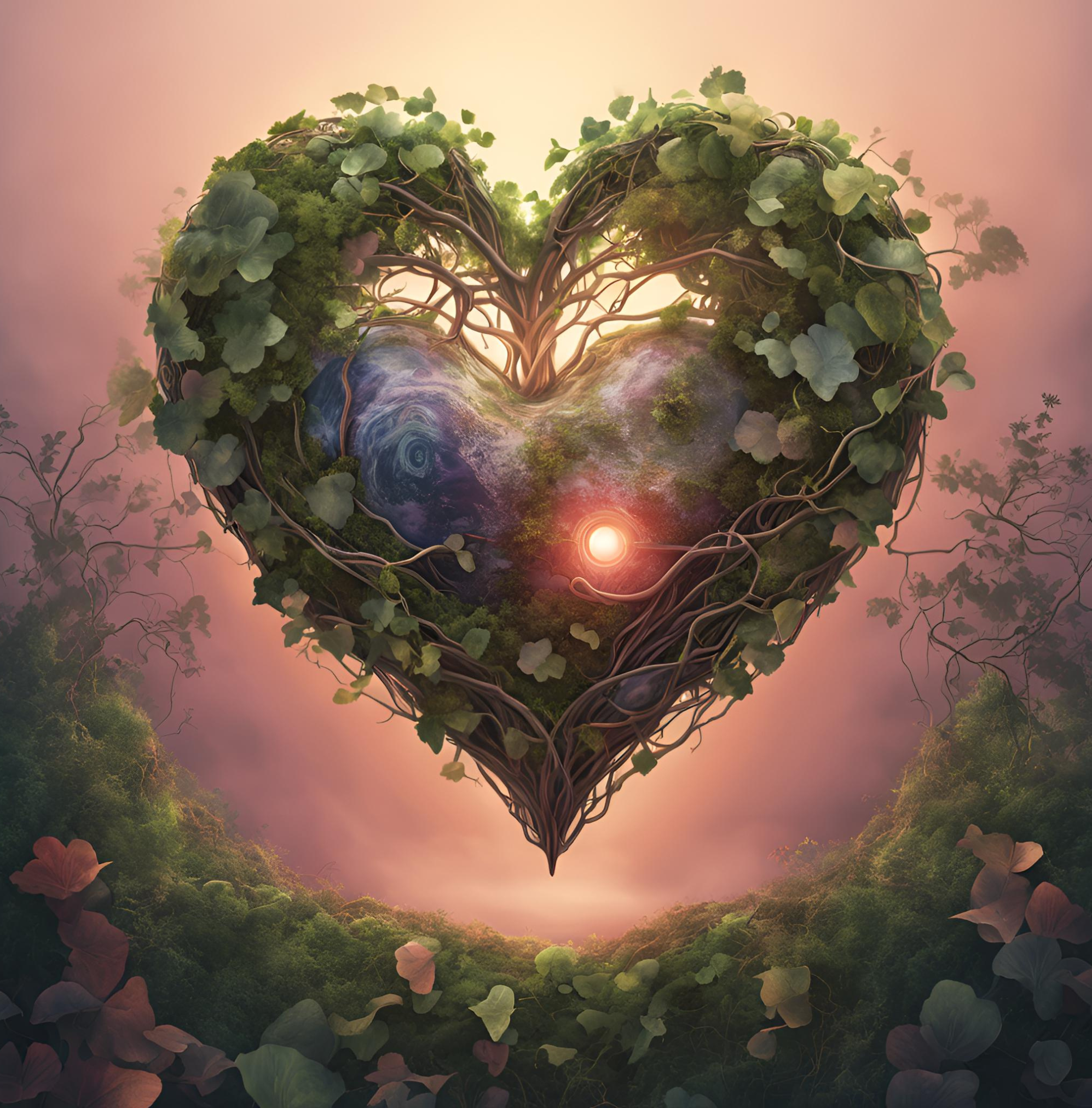Always Chasing, Never Arriving—Breaking the Cycle of Mental Resistance
“Most of the humans’ suffering isn’t caused by what’s actually happening, but by the refusal, the mental resistance, to accept it. […] We postpone peace, push against reality, and unknowingly feed a cycle of longing and lack.”
This article deals with how the mind’s resistance to the present moment fuels a vicious cycle of dissatisfaction. Driven by cultural ideals of control and achievement, we learn to delay peace—tying it to future outcomes that never truly satisfy. Blending ancient spiritual insight with modern psychological understanding, we offer a gentle and powerful invitation to step out of the cycle by embracing what is, living the serenity eternally available in the now.

Modern culture is obsessed with control. We measure success by productivity, organize our lives around plans and outcomes, and cling—desperately at times—to the belief that, if we just try hard enough, plan well enough, hustle long enough… everything will fall into place.
But what if control is an illusion?
What if letting go isn’t giving up, but actually setting ourselves free?
The Myth of Control
The current cultural model is built on predictability. It prefers systems that can be measured, scheduled, explained. It’s visible in every institution—from government to education to the economy: mechanisms designed to manage uncertainty, control behavior, and reward compliance. And this framework runs deep: it influences how we relate to each other, to things, even to ourselves — as we try to control our bodies through diet, time through schedules, and emotions through self-optimization.
On the surface, it all makes sense—control gives us the illusion of safety in an uncertain world.
But here’s the truth most of us avoid:
Life isn’t controllable. Not really.
Not the weather. Not other people’s actions. Not the timing of love, loss, healing, or growth.
And the more we resist this truth, the more we suffer. It promises safety, but delivers anxiety. Because what it really builds is resistance—against anything unplanned, unknown, or uncontrollable.
The tighter we grip, the more life slips through our fingers.
The Machinery of Suffering and the Price of Resistance
Most of the humans’ suffering isn’t caused by what’s actually happening, but by the refusal, the mental resistance, to accept it.
We often tell ourselves:
- “I’ll be happy when I get that job.”
- “When I finally get there, I’ll be okay.”
- “It’ll be fine once this phase is over.”
- “If only they would change, I could relax.”
These thoughts—disguised as motivation or strategy—are subtle rejections of the present moment. We postpone peace, push against reality, and unknowingly feed a cycle of longing and lack. This makes us fall into a chase that will never end.
Even when we “get” what we thought we needed, the mind quickly finds something new to chase, and redirects us to the next imagin. A better version, a new goal, a fresh condition for happiness. It is a loop that keeps the nervous system activated, the heart always waiting, and the present moment perpetually insufficient.
It never ends.
Anyway, this is not about blaming anyone. It isn’t even about a personal failure.
It’s what happens when a cultural framework prioritizes productivity over presence, output over being, control over connection. A culture that rewards striving while quietly shaming rest trains us to believe that we must always be chasing something.
But, as usually, cultural patterns and structures do not just shape the world outside, but become deeply inscribed into our bodies. They became part of our nervous systems, shape our thought loops and the way we relate to each other and ourselves.
These patterns train us to push life instead of allowing it.
To prove instead of rest.
To resist what is—in favor of what might be.
The Mind’s Design and the Freedom of Understanding
The suffering described above is not only cultural.
It’s also deeply human.
Contemplative traditions across time—like yoga and Buddhist psychology—have spoken to this. The mind, in its untrained state, resists reality. It clings to what it wants, rejects what it fears, and identifies with every story it creates. This dynamic is considered the root of suffering.
In yogic philosophy, these patterns are called vrittis—the mental fluctuations that obscure clarity. They distort perception, pulling awareness into repetitive loops of grasping and avoidance. And unless awareness is present, the mind runs on autopilot, generating discontent regardless of external circumstances.
Modern science mirrors this ancient insight.
The brain evolved for survival—not for peace. It’s wired to anticipate danger, control outcomes, and solve problems before they happen. The nervous system learned, over centuries of unpredictable environments, to stay on high alert. This served us once. But now, it often mistakes a delayed reply or a messy plan for existential threat.
The good news is that both ancient wisdom and modern research agree: this patterning is not fixed. It can be seen, softened and re-trained. Not through control, willpower or force, but through awareness, gentleness and practices that regulate the nervous system: returning the mind to the present moment. It is, and this is very important to understand, not fightingthe mind, but understanding and using it as a powerful tool. Only then can we stop being run by it.
Why We Chase: The Fear Beneath It All
Underneath the cultural push for control is something quietly pushing it forward: fear.
Fear that we aren’t safe unless we’re in charge.
Fear that we won’t get what we need unless we force it.
Fear that if we stop pushing, we’ll be forgotten, unloved, left behind.
So we try to manage every outcome and control becomes a coping mechanism for dealing with fear. It shapes behavior in subtle, intimate ways, and we try to micromanage everything: the pressure to say the right thing, text at the right time, choose the “correct” career path, calculate every decision like a chess move.
But life doesn’t respond to pressure and control the way culture expects it to:
in fact, life often resists that. The more pressure is applied, the more dissonance arises. Life responds to presence, not resistance.
What If You Trusted Instead?
Don’t get me wrong: to trust life is not to abandon discernment or to stop caring. Not at all! It means to shift the focus and act from alignment instead of fear. It means to release the expectation that things will come into place the way we imagine, when we imagine and, above all, releasing the expectation that effort and control guarantee outcomes.
It is not at all about becoming passive. It means shifting from forcing to flowing.
From pushing to allowing. From strategy to surrender.
Real trust says:
- “I will take action, I will release the outcome, and I will move forward without knowing what’s next.”
- “I do not need to know how it all unfolds to feel peace now.”
- “I can want something deeply, and still be okay without it.”
Even if framed differently by society, this is not weakness, but actually radical strength growing out of fearlessness, trust and patience. It’s the courage to say yes to what is, even when it doesn’t fit the plan we imagined. This creates space, allows softness and makes room for intuition to return and lead.
Desire without Dependency and the Energetics of Forcing vs. Allowing
I also want to clarify that wanting is not the issue. Desire is human, even sacred. It is our heart and soul expressing what it is here for. Still, there’s a difference between desiring something and depending on it for peace.
Culture often trains desire to become conditional: “I’ll be happy when.” Consequently, happiness becomes a state that is postponed for ever, chained to outcomes, and wrapped in expectations. Anyone who’s ever tried to force a cat to cuddle knows this truth intimately:
The more you chase, the more it runs. The same goes for relationships, creativity, inspiration, even healing. The more something is pushed, the more it resists.
It’s gentleness that invites.
It’s softness that magnetizes.
It’s trust that allows things to arrive when they’re truly meant to.
Divine timing might not be convenient.
Things rarely arrive when we want them the most. But they always arrive exactly when it’s right and when we’re truly ready to receive them.
And the older we get, the more we see it: the jobs we didn’t get, the loves that didn’t last, the painful pauses—each one turned out to be a doorway to something deeper, richer, more aligned.
Desire can live without pressure. You can be deeply fulfilled without your desires having become manifested in the world yet. That is what the shift is about.
How to Begin: From Striving to Surrender
You don’t have to renounce your desires.
But what would it feel like to uncouple your happiness from them?
To say: “I would love for this to happen. And I trust that what’s meant for me won’t miss me.”
I would like to invite you to simply start with small moments:
- When plans fall through, pause before reacting. Breathe. Ask: What’s being offered here instead? What might be waiting there for me, what might be the universe’s even bigger gift laying behind this “loss”?
- When you notice yourself hustling for worth, ask: What am I trying to prove—and to whom? What is it that I really need?
- When you feel the drive to control, try to tell yourself: I trust life’s timing more than my fear.
Over time, this creates space inside you.
Space where anxiety used to live.
Space where intuition can speak.
Space for life to unfold—not as you forced it, but as it was always meant to.
Letting go is not falling at all. It is where true empowerment lays, and where we can work together with the forces of life, with the earth, and with all that is.
Becoming Held
There is a deep peace that doesn’t come from achievement, but from allowing.
That peace comes from truly integrating and realizing that you are already enough. Already worthy. Already home. Already fully you and all you ever have to be.
It arises when you stop pushing, stop proving, stop managing every edge of the unknown—and let yourself be held by life itself.
The moment you stop thrashing in fear, you rise.
So let go, Love.
You’re not falling.
You’re finally being carried, by the most beautiful and powerful force out there: LOVE.
